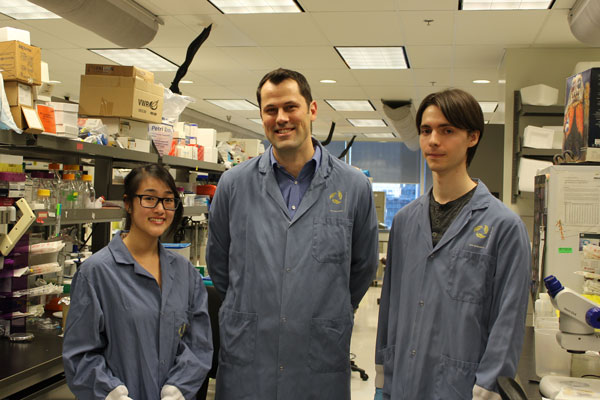A team of biomedical engineers and researchers from the University of Toronto and the Toronto General Research Institute have developed a new way to visualize biochemical reactions in cells. By offering new insight into how human cells work — or, in the case of diseased cells, how they malfunction — the technique could advance the study of diabetes, cancer and other conditions.
Their invention is a biological sensor based on fluorescent proteins that glow in response to laser light. It is a kind of molecular tag that binds to and lights up NADP+, a molecule found in all of our cells. NADP+ is involved in everything from breaking down fats and proteins to protecting against stress, and when it isn’t working properly, it can trigger undesired effects that result in conditions such as diabetes and arthritis.
“We wanted to monitor NADP+ due to its association with a large variety of human biological functions,” said Jonathan Rocheleau, an associate professor in the Institute of Biomaterials & Biomedical Engineering at the University of Toronto and scientist at the Toronto General Research Institute who supervised this work. “Our ability to collect this type of data with a much higher degree of precision will lend to a greater understanding of, and possibly cures for, a range of diseases.” The work was published today in Nature Methods.
The idea of using biological sensors to track molecules in cells under the microscope is not new, but current sensors have their limitations. “As a researcher, often what you care about is what’s going on with your molecule at the exact same time as some other parameter is changing,” said Rocheleau. “If you can’t see both at the same time, you’re essentially working in the dark.”

With current techniques, it typically takes two different-coloured sensors to properly track each molecule in the cell: when the molecule is activated, a transfer of energy results in one colour becoming brighter and the other dimmer. This means that tracking two molecules requires four colours, and three would require six. This can quickly turn microscope slides into an incomprehensible kaleidoscope.
This team’s new sensor, called Apollo-NADP+, responds using a single colour. When the molecule it is tracking increases in concentration, the sensor responds with a change in the polarization — that is, the direction— of the light emitted, rather than a change in colour. This polarization change can be detected using light filters similar to those found in 3D movie eyeglasses.

“We can tune the single colour output into a variety of frequencies, which gives us more flexibility in how we measure responses within the cell,” said William Cameron, a PhD student on Rocheleau’s team and the primary author the paper. “Moving away from two-colour limitations opens up a lot of new doors into the type of observations we can make about how cells use or misuse their NADP+ supply.”
Being able to observe NADP+ is only the beginning. The true innovation is the ability adapt the Apollo design to observe a host of other molecules within the cell, which in turn could offer new insights for a variety of diseases and conditions.
“We built this sensor as a blueprint for other investigators to adapt to their own research,” said Rocheleau. “Our design paves the way for others to follow and in the end build on our understanding of how the cells in our bodies actually work.”




